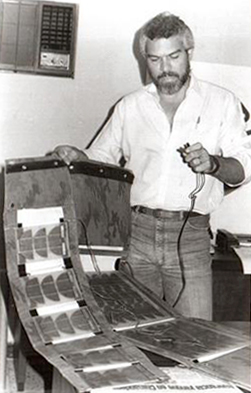Related Research Articles

Rural electrification is the process of bringing electrical power to rural and remote areas. Rural communities are suffering from colossal market failures as the national grids fall short of their demand for electricity. As of 2017, over 1 billion people worldwide lack household electric power – 14% of the global population. Electrification typically begins in cities and towns and gradually extends to rural areas, however, this process often runs into obstacles in developing nations. Expanding the national grid is expensive and countries consistently lack the capital to grow their current infrastructure. Additionally, amortizing capital costs to reduce the unit cost of each hook-up is harder to do in lightly populated areas. If countries are able to overcome these obstacles and reach nationwide electrification, rural communities will be able to reap considerable amounts of economic and social development.

The Solar Electric Light Fund (SELF) is a non-profit organization, established in 1990 and based in Washington, D.C. Their mission is to design and implement solar energy solutions to assist those in poor communities where energy, education, health care, and agricultural development are at risk. Since our establishment, SELF has completed several projects in more than 20 countries, forexample; A solar powered drip irrigation in Benin, a health care centre in Haiti, telemedicine in the Amazon rainforest, online learning platform in South Africa, and a microenterprise development in Nigeria.

Solar power is a fast developing industry in India. The country's solar installed capacity was 63.303 GWAC as of 31 December 2022. Solar power generation in India ranks fourth globally in 2021.
For solar power, South Asia has the ideal combination of both high solar insolation and a high density of potential customers.

The developing nations of Africa are popular locations for the application of renewable energy technology. Currently, many nations already have small-scale solar, wind, and geothermal devices in operation providing energy to urban and rural populations. These types of energy production are especially useful in remote locations because of the excessive cost of transporting electricity from large-scale power plants. The applications of renewable energy technology has the potential to alleviate many of the problems that face Africans every day, especially if done in a sustainable manner that prioritizes human rights.

A solar lamp, also known as a solar light or solar lantern, is a lighting system composed of an LED lamp, solar panels, battery, charge controller and there may also be an inverter. The lamp operates on electricity from batteries, charged through the use of solar panel
The Aryavart Bank (AB) is an Indian Regional Rural Bank (RRB) in Uttar Pradesh established on 1 April 2019. The bank was formed by the amalgamation of Gramin Bank of Aryavart and Allahabad UP Gramin Bank. It currently has 1365 branches and 22 regional offices in rural areas of Uttar Pradesh, around Lucknow. It functions under Regional Rural Banks' Act 1976 and is sponsored by Bank of India.Allahabad UP Gramin Bank and Gramin Bank of Aryavart are mergering with name Aryavart Bank e.r.f 01.04.2019. It is under the ownership of Ministry of Finance, Government of India.

ECAMI is a renewable energy business based in Nicaragua, focusing on solar photovoltaics, wind power and hydroelectric system.
Innovation: Africa is a non-profit 501(c)(3) organization which brings Israeli solar, water and agricultural innovations to rural African villages. Since its establishment in 2008, the organization has completed over 880 projects providing light and solar energy to schools and medical centres and crucially, pumping clean water to more than 4 million people across 10 African countries. Innovation: Africa maintains headquarters in the US and Israel and has projects across Uganda, Malawi, Tanzania, Zambia, South Africa, Cameroon, Ethiopia, the Democratic Republic of Congo, Senegal, and Eswatini.
The Madhya Pradesh Rural Livelihoods Project (MPRLP) works with local village assemblies, Gram Sabha, to facilitate and guide community-driven collective and individual action to reduce poverty in the state of Madhya Pradesh, India.
Husk Power Systems, founded in 2008, is a company based in Fort Collins, Colorado, US, that provides clean energy services to off-grid or weak grid rural communities in East Africa, West Africa and South Asia, primarily by building renewable energy mini-grids/micro-grids. Its original technology generated electricity using a biomass gasifier that created fuel from rice husks, a waste product of rice hullers that separate the husks as chaff from the rice, a staple food in both Asia and Africa. In the mid-2010s, with the rapid decline in the price of solar PV and batteries, Husk pivoted its business model to focus more on solar-plus-storage mini-grids, while continuing to use biomass in combination with solar to serve communities with larger electricity demand. In 2021, Husk Power was recognized in the REN21 Renewables Global Status Report as the first mini-grid company to achieve significant scale, by surpassing 100 solar hybrid community mini-grids, and 5,000 small business customers. In 2022, Husk signed an Energy Compact with the United Nations, in which it set a target of building 5,000 mini-grids and connecting at least 1 million customers by 2030.
In Guyana, the areas outside of the coastal plain are referred to as hinterland. Approximately twenty percent of the Guyanese population live in the hinterland. The population mostly consists of Amerindian communities who have little access to modern energy services such as electricity, light and modern fuels for cooking and transportation. This situation contrasts with the coastal plain, where there is access to the electricity grid. Several initiatives are in place to improve energy services in the hinterland.

Su-Kam Power Systems Ltd. is an Indian power provider which sells its products in more than 90 countries. The company provides power back-up solutions for both domestic as well as industrial markets, and focuses on eco-friendly energy solutions like solar power. Some of the major products include solar charge controller, solar power conditioning units, solar grid-tie inverters, solar off-grid power systems, home inverters, home UPS, Online UPS, line interactive UPS, batteries, battery chargers and battery equalizers.
Gram Power is an energy technology company founded in 2010 out of University of California Berkeley. The company provides cutting-edge Smart Grid technologies to address the electrification challenges in developing nations. Its founders are Yashraj Khaitan, and Jacob Dickinson, engineering graduates of the University of California, Berkeley, who are being mentored by Eric Brewer, a vice-president of infrastructure at Google and a professor at Berkeley. They set up India's first Solar Powered Smart Microgrid in the Rajasthan hamlet of Khareda Lakshmipura in March 2012, providing energy for lights, buttermilk machines, televisions, and fans. Gram Power's core innovation is in their Smart Distribution technology, consisting of their Smart Meters and Grid Monitoring Systems to provide on-demand, theft-proof power with a unique pay-as-you-use schedule that is determined by the end user. The company's operation has been praised by American journalist Thomas Friedman as "the most exciting" energy technology innovation he has seen in India and was selected among the top 10 Cleantech Innovations by NASA in 2011. Gram Power is reportedly "on pace to reach 20,000 homes and have 100 rural telecom towers covered with solar panels for a generation" for 2013.
Jyotigram Yojana is an initiative of the Government of Gujarat, India, to ensure that a 24-hour, three-phase quality power supply is available to rural areas of the state and supply power to farmers residing in scattered farmhouses through feeder lines with specially designed transformers. The scheme was announced in 2006 by the President of India, A. P. J. Abdul Kalam. In 2011 it was announced by the Government of India that it would accept Gujarat's Jyotigram project as a flagship scheme for its Twelfth five-year plan.
Concept of smart villages is a global modern approach for off-grid communities. Vision behind this concept is to assist the policy makers, donors and socio-economic planner for rural electrification worldwide.
Clementine Chambon is a chemical engineer at Imperial College London who works on energy solutions for energy-deprived countries. She is the CTO of Oorja Development Solutions, a social enterprise that provides clean energy access to off-grid communities in rural India.
A mini-grid is an aggregation of loads and one or more energy sources operating as a single system providing electric power and possibly heat isolated from a main power grid. A modern mini-grid may include renewable and fossil fuel-based generation, energy storage, and load control. A mini grid can be fully isolated from the main grid or interconnected to it. If it is interconnected to the main grid, it must also be able to isolate (“island”) from the main grid and continue to serve its customers while operating in an island or autonomous mode. Mini-grids are used as a cost-effective solution for electrifying rural communities where a grid connection is challenging in terms of transmission and cost for the end user population density, with mini grids often used to electrify rural communities of a hundred or more households that are 10 km or more from the main grid.
Unite to Light is a Santa Barbara-based nonprofit organization whose mission is to “manufacture and distribute efficient, durable, low cost solar lamps and solar chargers to people without access to electricity." As of 2019, over 120,000 lights had been distributed to more than 70 countries with the goal of improving education, health, and disaster preparedness.
References
- ↑ "Sarvantara village in UP's Bahraich sees light after 69 years of Independence". hindustantimes.com.
- ↑ "Lighting lives". thehindu.com.
- ↑ "UK student lights up Indian village with solar power". indiatoday.in.
- ↑ "UK student Clementine Chambon lights up Sarvantara village in Uttar Pradesh with solar power". financialexpress.com.